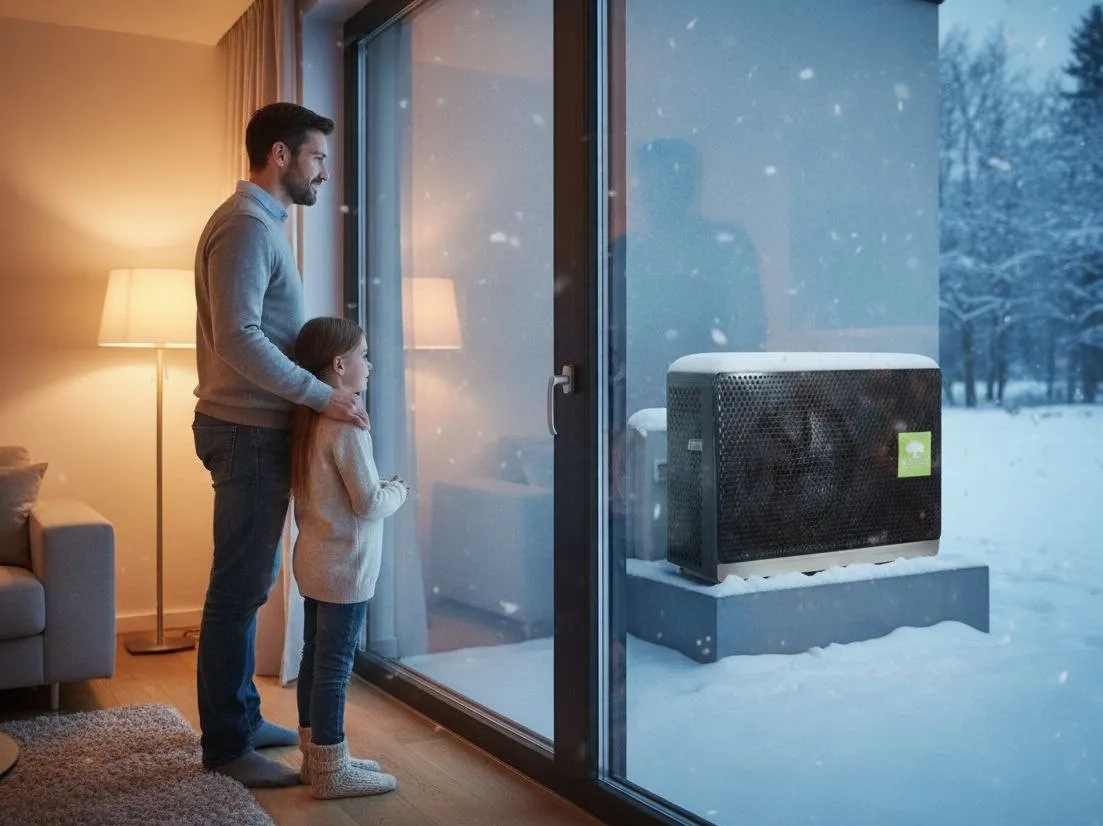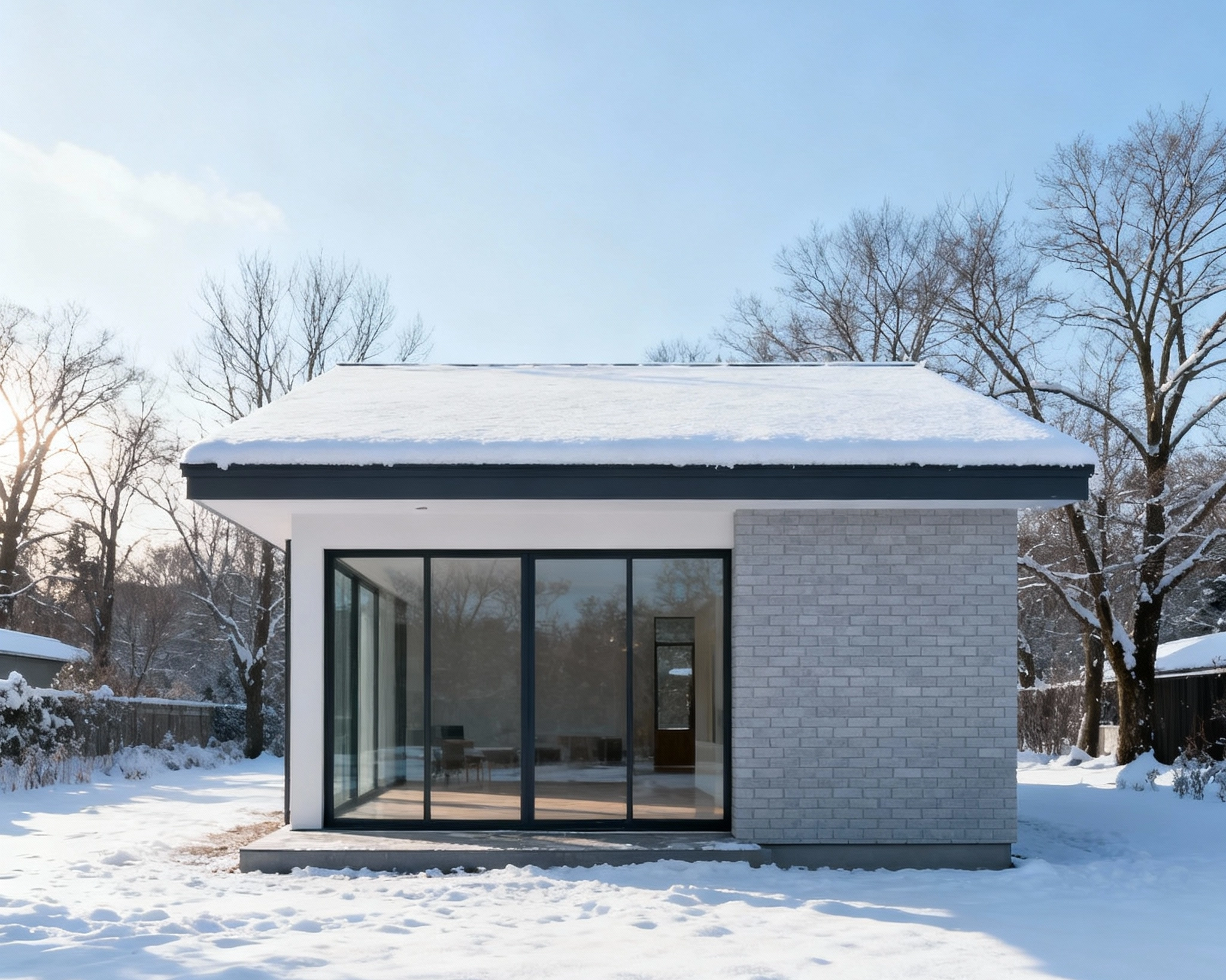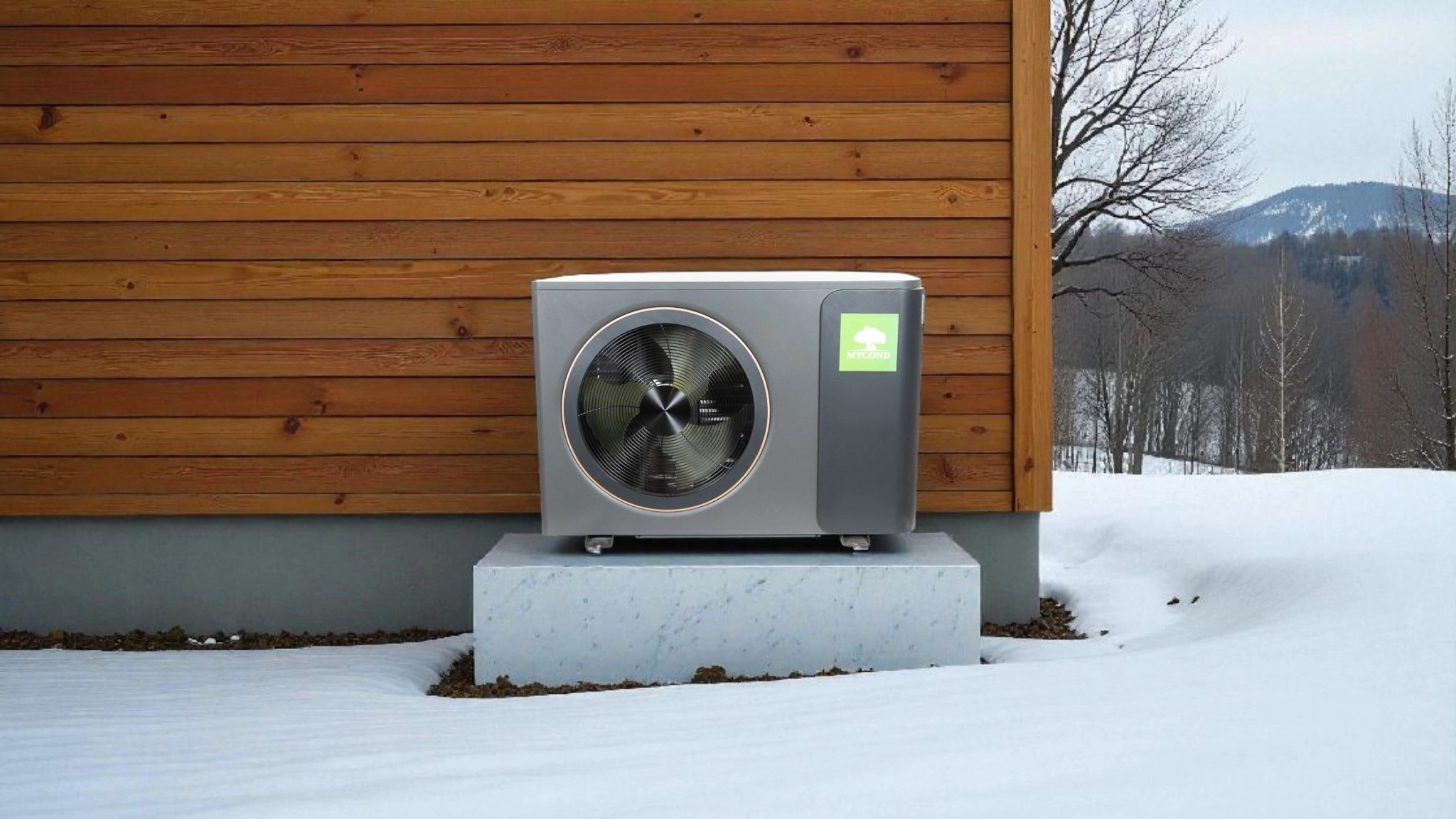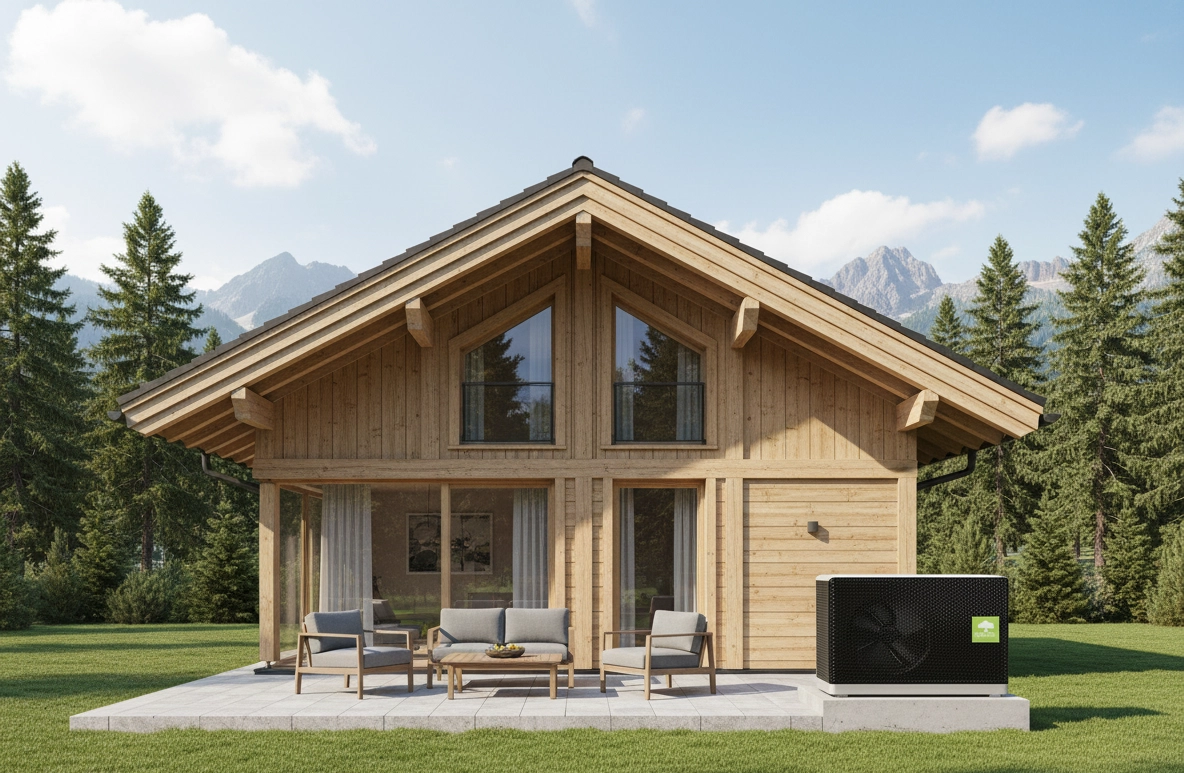
The Mycond air-to-water heat pump is an optimal modern solution for heating a 100 m² house. It combines high energy efficiency, environmental friendliness, and significant electricity savings compared to traditional heating systems. It works by extracting thermal energy from the outdoor air even at low temperatures down to -25°C and converting it into heat for your home.
Thanks to inverter technology, the heat pump automatically adapts to changes in outdoor temperature, delivering the required amount of heat with minimal electricity consumption. The coefficient of performance (COP) reaches 4–5, which means: for every 1 kW of electricity consumed you receive 4–5 kW of thermal energy. That’s 4–5 times more efficient than a conventional electric boiler.
In addition, Mycond heat pumps provide both heating in winter and cooling in summer (especially with fan coils), ensuring year-round comfort in your home. But it’s important to understand that choosing the right model is not just about the 100 m² floor area.

Why floor area isn’t the only selection criterion
A 100 m² area is not the only indicator for selecting a heat pump. You need to calculate actual heat losses, which can differ by up to a factor of four — from 3 to 12 kW, depending on insulation quality. But that’s not all!
It is critically important to understand that the nominal capacity of a heat pump is specified under ideal conditions: +7°C outdoor air and +35°C outlet water temperature. In real winter conditions at -15°C and +55°C for old radiators, the output drops by 2–3 times.
Therefore, selecting a heat pump is not just heat loss divided by nominal capacity, but a more complex calculation. In this article you’ll find a detailed explanation of this critical difference, a simple heat loss calculation method, and 4 concrete real-world selection scenarios with verification of real output under design conditions — without complicated tables, but with honest numbers.
Express method for calculating heat losses according to building physics standards
Here are the specific heat loss norms per square meter:
- New energy-efficient houses: 30–50 W/m², which for 100 m² gives 3–5 kW
- Modernized houses: 50–70 W/m², gives 5–7 kW
- Old houses without insulation: 100–120 W/m², gives 10–12 kW
Formula for calculating the required heat pump capacity:
Heat losses × safety factor 1.1 (10% margin)
Example: old 100 m² house, 110 W/m² gives 100 × 110 = 11,000 W or 11 kW of heat loss. Multiply by 1.1 — you get 12.1 kW.
But note! This is the required thermal output at the design temperature of your region (the lowest outdoor temperature typical for your location, usually from -10°C to -25°C), not the nominal capacity of the heat pump as specified by the manufacturer at +7°C.
This is an approximate quick estimate. For an accurate calculation considering all factors (ceiling height, number and quality of windows, building orientation, wall thickness) it’s better to consult professionals. But the provided norms give good guidance for choosing a model. The main thing is to understand the difference between nominal and actual output.
CRITICALLY IMPORTANT: nominal vs actual heat pump output
The nominal capacity stated by the manufacturer (for example, 9 kW or 12 kW) is the capacity under standard test conditions: +7°C outdoor air and +35°C outlet water temperature (denoted as A7/W35 according to European standard EN 14511). These are ideal conditions for a heat pump: high COP, maximum efficiency.
But in real operation during winter the conditions are quite different. Outdoor temperature can be -10°C, -15°C, -20°C, and the water temperature needed for old radiators is +50–55°C. Under such conditions a heat pump’s output drops by 1.5–3 times depending on the model and technology.
Let’s look at this output drop using the BeeSmart MHCS035 with a 9 kW nominal rating as an example:
- At +7°C/W35: actual output 9.2 kW (100% of nominal), COP 4.48
- At -7°C/W35: actual output 5.7 kW (62% of nominal), COP 2.97
- At -15°C/W35: actual output 4.4 kW (48% of nominal), COP 2.40
- At -7°C/W55: actual output 4.88 kW (53% of nominal), COP 1.73
- At -15°C/W55: actual output 3.63 kW (39% of nominal), COP 1.39
Critical conclusion: if your house has 9 kW heat losses at -15°C and requires +55°C water temperature for old radiators, then the BeeSmart heat pump with a 9 kW nominal rating will deliver only 3.63 kW of actual output, which is absolutely insufficient. You need a heat pump with at least 19–24 kW nominal output or a bivalent scheme (a smaller heat pump plus a backup boiler).
This is the most common mistake when selecting equipment — people only look at nominal capacity and don’t consider real operating conditions.
All manufacturers provide detailed performance tables at various temperatures. You must look at the actual output at your region’s design temperature and at the required water temperature: W35 for underfloor heating, W45–50 for low-temperature radiators, W55 for old radiators. These figures, not the nominal rating, determine whether a model is suitable.

Comparison of three Mycond heat pump series
MBasic
Models: MHM-U06HL (7.2 kW), MHM-U09HL (9.7 kW), MHM-U12HL (11.9 kW)
Compressor: Zhuhai Landa
SCOP: 4.50–4.65, class A+++ at W35
Features: monoblock design, basic functionality, remote control, Mycond app, special heat exchanger coating, operation down to -25°C
For whom: private residential houses with a simple heating layout (single circuit), an optimal balance of capability and simplicity without overpaying for unnecessary features
BeeSmart
Models: MHCS035 NBS/UBS (9 kW), MHCS045 NBS/UBS (12 kW), MHCS050 NBS/UBS (15 kW), MHCS070 NBS/UBS (19 kW)
Compressor: Mitsubishi Electric
SCOP: 4.72–4.98 (the highest among Mycond), class A+++
Features: split system or AIO (all-in-one) with indoor hydronic module and DHW tank, weather-compensated control, smart control of two circuits via mixing valves, Modbus integration (smart home), Smart Grid, compressor frequency up to 90 Hz
For whom: complex systems with two or more circuits, automation, smart home integration, commercial sites, cascade schemes, maximum efficiency and functionality
BeeThermic
Models: MHCM 06 SU1A (6 kW), MHCM 10 SU1A (10 kW), MHCM 14 SU3A (14 kW), MHCM 18 SU3A (18 kW), MHCM 24 SU3A (24 kW)
Compressor: Panasonic Wanbao with EVI technology (Enhanced Vapor Injection)
SCOP: 4.47–4.58, class A+++ at W35 and A++ at W55
Features: monoblock, EVI technology for extreme frosts (retains 55–65% of capacity at -15°C and 60–70% at -25°C, when conventional heat pumps lose 50–60% of nominal), intelligent defrosting, resilience to failures, auto-recovery, operation tested at -25°C
For whom: cold climate zones where temperatures are regularly below -15°C, mountainous areas, harsh winters, when stable operation without loss of output in frosts is critically important, monovalent scheme in a cold climate
All three series have A+++ class, Heat Pump Keymark certification, R32 refrigerant, and supply temperature up to +55°C, which makes them suitable for most heating systems, including old radiators. The difference is in specialization: MBasic — universal for simple systems, BeeSmart — for complex systems with automation, BeeThermic — for extremely cold climates. But the most important thing when choosing a model is to look not only at the nominal capacity, but at the actual output under your specific operating conditions.
4 practical selection scenarios with verification of actual output
Scenario A: New energy-efficient house
Characteristics: heat losses 4 kW (calculation: 100 m² × 40 W/m²)
Heating system: underfloor heating with a supply temperature of +30–40°C or fan coils with +35–45°C supply
Climate zone: temperate, design temperature -15°C
Recommendation: Mycond MBasic MHM-U06HL (nominal capacity 7.2 kW)
Actual output check: at -15°C/W35, the MHM-U06HL delivers approximately 4.5–5 kW of actual output, which is more than the 4 kW heat losses, so it’s an ideal fit
Justification: a low-temperature system (underfloor heating or fan coils, W35) allows you to achieve a high COP of 4.3–4.5 even at -15°C. The heat pump retains 60–70% of nominal capacity, which is sufficient to cover 4 kW of heat losses with a margin. A monovalent scheme without a backup source is the most economical option
Alternative: BeeSmart MHCS035 (nominal 9 kW) if complex automation, weather-compensated control or smart home (Modbus) integration is planned, but for a simple house with a single heating circuit this functionality is excessive
Scenario B: Modernized house with a combined system
Characteristics: heat losses 7 kW (calculation: 100 m² × 70 W/m²)
Heating system: combined — underfloor heating on the first floor plus low-temperature radiators or fan coils on the second floor, supply temperature +45–50°C
Climate zone: temperate, design temperature -15°C
Recommendation: MBasic MHM-U09HL (nominal capacity 9.7 kW)
Actual output check: at -15°C/W45, the MHM-U09HL delivers approximately 6–6.5 kW of actual output, which is less than 7 kW of heat losses but sufficient for the bivalent point. At -10°C it delivers 7–8 kW, fully covering the load
Justification: a light bivalent scheme is optimal for such a system. The MHM-U09HL heat pump operates independently down to the bivalent point (approximately -10°C), which covers 85–90% of the heating season. At lower temperatures (-10°C to -20°C) a small electric backup of 2–3 kW turns on automatically to maintain comfort
Alternative: BeeSmart MHCS045 (nominal 12 kW) if you need to control two circuits with different temperature programs via mixing valves (first floor — underfloor heating +35°C, second floor — radiators +50°C) with automatic calculation of the optimal temperature for each circuit

Scenario C: Old house with old radiators
Characteristics: heat losses 11 kW (calculation: 100 m² × 110 W/m²)
Heating system: old cast-iron or steel radiators requiring +50–55°C supply temperature
Climate zone: temperate, design temperature -15°C
Recommendation: MBasic MHM-U12HL (nominal capacity 11.9 kW) plus a MANDATORY bivalent scheme with a backup source (4–5 kW electric boiler or the existing gas boiler)
Actual output check: critically important — at -15°C/W55 the MHM-U12HL delivers only 5–6 kW of actual output, which is less than half of the 11.9 kW nominal and absolutely insufficient for 11 kW heat losses, so a monovalent scheme is impossible
Justification of the bivalent scheme: the MHM-U12HL heat pump covers the base load down to the bivalent point (approximately -7°C). At this temperature and W55 it delivers about 7–8 kW, which is sufficient for the home’s heat losses at -7°C. At lower temperatures (-7°C to -20°C) a 4–5 kW backup boiler turns on automatically to add the necessary output
Alternative: BeeThermic MHCM 14 SU3A (nominal 14 kW) if the region has frosts below -15°C, where EVI technology provides an advantage. At -15°C/W55 the BeeThermic MHCM 14 SU3A delivers 10.25 kW of actual output (73% of nominal, almost twice that of conventional heat pumps) thanks to EVI technology
Scenario D: Cold climate with prolonged frosts
Characteristics: any house type, 100 m², heat losses 8 kW
Key feature: climate zone with regular temperatures below -15°C and frosts down to -25°C for weeks, where conventional heat pumps lose 50–60% of nominal capacity; design temperature -25°C
Heating system: any (radiators, fan coils, underfloor heating), water temperature W45
Recommendation: BeeThermic MHCM 14 SU3A (nominal capacity 14 kW), necessarily due to EVI technology
Actual output check: critically important calculation — heat losses are 8 kW at -15°C, but at -25°C heat losses increase by another 25–30% to 10–10.4 kW. A conventional heat pump like MBasic or BeeSmart with 12 kW nominal at -25°C/W45 delivers only 4–5 kW of actual output (33–42% of nominal) — absolutely insufficient. The BeeThermic MHCM 14 SU3A with EVI technology at -25°C/W45 delivers 7.34 kW (52% of nominal, almost twice that of conventional HPs), but still below the required 10 kW. Therefore, for a monovalent scheme you need the BeeThermic MHCM 18 SU3A (nominal 18 kW)
Justification: for cold climates with prolonged harsh winters, only EVI technology ensures reliable, stable operation without critical loss of output at extreme frosts. Enhanced Vapor Injection is an additional heat exchanger and a vapor injection valve into the compressor that increases performance at low temperatures
Alternatives for such a climate are practically nonexistent. MBasic and BeeSmart in these conditions will require a very powerful backup boiler of 6–8 kW, which negates the economic benefit of a heat pump

Monovalent vs bivalent scheme: when each is more advantageous
There are two main heat pump operating schemes:
- Monovalent — the heat pump operates alone, without a backup source, covering 100% of heat losses at any temperature. Suitable for well-insulated houses with low heat losses (30–50 W/m²) and low-temperature systems (underfloor heating, fan coils, W35–40) in temperate climates without prolonged frosts below -10...-15°C, or for cold climates with BeeThermic EVI.
- Bivalent scheme — the heat pump covers the base load (70–85% of the heating season), and at peak frosts below the bivalent point a backup boiler (electric or gas) turns on automatically. Suitable for old houses with high heat losses (100–120 W/m²) and high-temperature systems (old radiators, W50–55).
The bivalent point is the outdoor temperature at which the actual output of the heat pump can no longer cover the house’s heat losses and a backup source must be engaged. Usually the bivalent point is around -5 to -10°C for most systems.
Example of calculating the bivalent point: old 100 m² house, heat losses 11 kW at -15°C, heating system — old radiators W55. Install MBasic MHM-U12HL (nominal 11.9 kW). At -7°C/W55 it delivers about 7–8 kW of actual output. The house’s heat losses at -7°C decrease linearly to approximately 6–7 kW — the heat pump fully covers them. The bivalent point is at -7°C. At lower temperatures a 5 kW electric boiler turns on.
When the monovalent scheme is more advantageous: new well-insulated houses with heat losses up to 50 W/m², low-temperature systems (underfloor heating W35 or fan coils W40), temperate climate without prolonged frosts below -10...-15°C.
When the bivalent scheme is more advantageous: old houses with 100–120 W/m² heat losses, high-temperature systems (old radiators W50–55), temperate climate with periodic frosts below -10...-15°C. It’s more economical to install a heat pump that covers 70–85% of the load plus a 3–5 kW backup than to buy a very powerful monovalent heat pump.
Types of heating systems and their impact on sizing
Underfloor heating (supply temperature +30–40°C) — the most optimal option for a heat pump. All three Mycond series operate with a maximum COP of 4.3–5.0 even at -15°C and retain 60–70% of nominal capacity. The most economical operation, suitable for all series, monovalent scheme possible.
Fan coils (supply temperature +35–45°C) — universal units with a fan. The main advantage is the dual function: heating in winter, cooling in summer when the heat pump is switched to cooling mode. The temperature is optimal for high COP, and rooms heat up quickly thanks to forced air circulation. At -15°C/W40 heat pumps retain 55–65% of nominal capacity. Ideally suited to all three Mycond series, especially BeeSmart, which has automatic heating-cooling switching for year-round comfort.
Low-temperature radiators (supply temperature +45–50°C) — modern aluminum or bimetal radiators with a large surface area designed to work with heat pumps. All three series operate with COP 3.0–3.8. At -15°C/W45 heat pumps retain 45–55% of nominal capacity. Suitable for heating upgrades; a light bivalent scheme is often needed.
Old cast-iron or steel radiators (supply temperature +50–55°C) — all three Mycond series provide up to +55°C, so they are suitable for modernization without replacing radiators, but COP at W55 is significantly lower (2.0–2.8). At -15°C/W55 heat pumps retain only 35–45% of nominal capacity. It is critically important to account for this drop when selecting a model. For old radiators a bivalent scheme is almost always required.
Installation: key points
Monoblock (MBasic and BeeThermic) — all components in one outdoor unit. Advantages: no refrigerant lines required, easier permitting, faster installation.
Split system (BeeSmart) — outdoor unit plus indoor hydronic module. Advantages: compact outdoor unit, indoor module in the boiler room (convenient), greater flexibility. Disadvantage: refrigerant lines required.
Three hydraulic connection schemes:
- Direct — for simple systems (single circuit)
- Through a hydraulic separator — for multiple circuits
- With a buffer tank (100–300 liters) — recommended for all systems. The buffer tank compensates for losses during defrosting, stores heat, and ensures stable system operation
FAQ: answers to the most common questions
How do I calculate heat losses for a 100 m² house by myself?
Multiply the area (100) by the specific heat losses: for a new house — 30–50 W/m² (gives 3–5 kW), for a modernized house — 50–70 W/m² (gives 5–7 kW), for an old house — 100–120 W/m² (gives 10–12 kW). Then multiply by a 1.1 factor for a margin. IMPORTANT: this is a quick ballpark estimate for preliminary model selection. For an accurate heat engineering calculation, consult qualified specialists.
Why is the nominal capacity 9 kW, but it actually delivers 4 kW?
The nominal capacity is specified under standard test conditions (+7°C outdoor, W35 water temperature). These are ideal conditions. In reality, in winter at -15°C/W55 for old radiators, output drops by 2–3 times. This is normal for all heat pumps. You must look at the performance tables for your specific operating conditions.
What’s the difference between MBasic, BeeSmart, and BeeThermic?
MBasic: basic functionality, monoblock, Zhuhai Landa, SCOP 4.50–4.65, for simple systems. BeeSmart: maximum automation, Mitsubishi Electric, SCOP 4.72–4.98 (highest), two circuits, weather compensation, Modbus, for complex systems. BeeThermic: EVI technology, Panasonic, SCOP 4.47–4.58, for cold climates, retains 55–65% of capacity at -15°C. All have A+++, Heat Pump Keymark, R32, up to +55°C.
Is a backup boiler necessary?
It depends on insulation, the heating system, and climate. For a new house with underfloor heating (W35) in a temperate climate, a monovalent scheme is sufficient. For an old house with old radiators (W55), a bivalent scheme is better (heat pump plus 3–5 kW backup). For cold climates (below -15°C), it’s better to use BeeThermic with EVI (monovalent) or other series plus a powerful backup.
What are the advantages of fan coils?
Fan coils (supply temperature +35–45°C) are optimal for heat pumps. The main advantage is versatility: heating in winter, cooling in summer. Fast warm-up thanks to the fan, compact size. Suitable for all Mycond models, especially BeeSmart with automatic mode switching.
Which series is the most efficient?
By SCOP — BeeSmart (4.72–4.98, the highest). But efficiency depends on conditions. For well-insulated homes with W35, all operate with COP 4.5–5.0. For cold climates, BeeThermic is more effective thanks to EVI. For complex systems, BeeSmart optimizes via weather compensation. The most efficient one is the one that suits your conditions: MBasic for simple systems, BeeSmart for complex systems, BeeThermic for cold climates.
Conclusion: how to correctly choose a heat pump for a 100 m² house
Correct selection of a heat pump for a 100 m² house is based on four key factors:
- Calculation of real heat losses according to building physics standards
- CRITICALLY IMPORTANT: understanding the difference between nominal and actual output under your specific operating conditions. Nominal is specified at +7°C/W35, while in reality at -15°C/W55 the output drops by 2–3 times. This is the most common mistake!
- Determining the type of heating system and the optimal scheme: monovalent (for low-temperature systems W35–40) or bivalent (for high-temperature W50–55)
- Considering the climate zone and special requirements
Mycond offers a complete lineup of heat pumps: MBasic for simple residential systems (optimal balance), BeeSmart for complex systems with automation (highest efficiency, SCOP up to 4.98), BeeThermic for cold climates (unique EVI technology, stable operation at -25°C). All have A+++, Heat Pump Keymark, R32, and a supply temperature up to +55°C.
Need help selecting the optimal Mycond model considering actual heat losses, actual output under your operating conditions, heating system type, and climate? Our engineers are ready to provide a free consultation, recommend the optimal model and connection scheme, and verify actual output at your region’s design temperature.
Contact us right now by the phone number listed on the page, or fill out the feedback form at the bottom of the page, and our specialist will get back to you. Don’t repeat the typical mistake of relying only on nominal capacity and floor area. Entrust equipment selection to Mycond professionals!